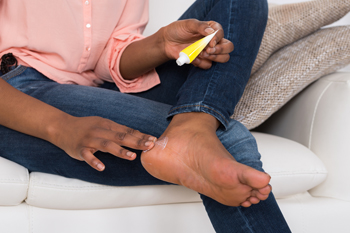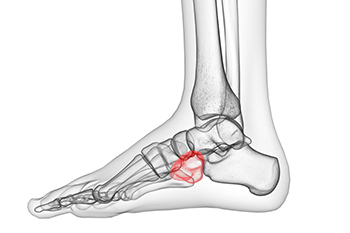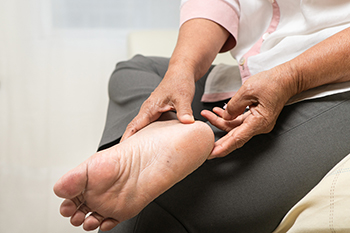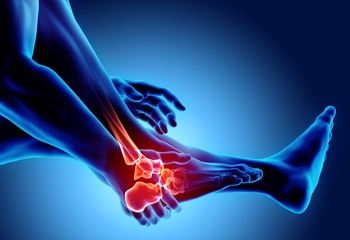Connect With Us
Blog
Items filtered by date: July 2022
What Causes Cracked Heels

For any person who cares about the health and appearance of their feet, cracked heels can pose a unique problem. This unattractive and potentially uncomfortable condition occurs when the skin surrounding the heels becomes thick and dry, producing a cracked texture. It is very important to familiarize yourself with the causes of cracked heels as this can reduce your chance of developing the condition. The principal cause of this ailment is lacking sufficient moisture in the skin of the heels. For example, if someone fails to properly moisturize and protect the elasticity of the skin in their heels, they are increasing their chances of developing cracked heels. Additionally, prolonged exposure to water can also cause cracked heels in some cases. This is because water can diminish important oils in the heels that keep the skin elastic. Therefore, if you are someone who spends a significant amount of time in damp or moist environments, you may be putting yourself at a greater risk of developing cracked heels. These are just some of the many causes of cracked heels. To learn more, contact a podiatrist who can help with your cracked heels.
Cracked heels are unsightly and can cause further damage to your shoes and feet. If you have any concerns, contact Michael Tomey, DPM from Cary Foot & Ankle Specialists. Our doctor can provide the care you need to keep you pain-free and on your feet.
Cracked Heels
Cracked heels appear unappealing and can make it harder for you walk around in sandals. Aside from looking unpleasant, cracked heels can also tear stockings, socks, and wear out your shoes. There are several methods to help restore a cracked heel and prevent further damage.
How Do You Get Them?
Dry skin is the number one culprit in creating cracked heels. Many athletes, walkers, joggers, and even swimmers suffer from cracked heels. Age and skin oil production play a role to getting cracked heels as well.
Promote Healing
Over the counter medicines can help, especially for those that need instant relief or who suffer from chronic dry feet.
Wear Socks – Wearing socks with medicated creams helps lock in moisture.
Moisturizers – Applying both day and night will help alleviate dryness which causes cracking.
Pumice Stones – These exfoliate and remove dead skin, which allows for smoother moisturizer application and better absorption into the skin.
Change in Diet
Eating healthy with a well-balanced diet will give the skin a fresh and radiant look. Your body responds to the kinds of food you ingest. Omega-3 fatty acids and zinc supplements can also revitalize skin tissue.
Most importantly, seek professional help if unsure how to proceed in treating cracked heels. A podiatrist will help you with any questions or information needed.
If you have any questions, please feel free to contact our office located in Cary, NC . We offer the newest diagnostic and treatment technologies for all your foot care needs.
It's Time for Beautiful Feet
Where is the Cuboid Bone?

One of the stabilizer bones in the foot is referred to as the cuboid bone. It is shaped like a cube, and is located on the outside of the foot. It acts like a pulley, and is instrumental in helping the foot point downward. Cuboid syndrome is the partial dislocation of the cuboid bone where it connects to the heel. It can result from an ankle sprain, or from excessively rolling the foot inward, which can happen from participating in certain sporting activities. Common symptoms experienced with this ailment include pain on the outside of the foot, limited range of motion, and swelling. Treatment generally begins with elevating the affected foot, followed by wearing a supportive walking boot. Strengthening exercises may be performed that can benefit the entire foot, and leisure activities can gradually return to normal. If you have sustained an ankle injury, please speak with a podiatrist who can properly diagnose cuboid syndrome and recommend the correct treatment for you.
Cuboid syndrome, also known as cuboid subluxation, occurs when the joints and ligaments near the cuboid bone in the foot become torn. If you have cuboid syndrome, consult with Michael Tomey, DPM from Cary Foot & Ankle Specialists. Our doctor will assess your condition and provide you with quality foot and ankle treatment.
Cuboid syndrome is a common cause of lateral foot pain, which is pain on the outside of the foot. The condition may happen suddenly due to an ankle sprain, or it may develop slowly overtime from repetitive tension through the bone and surrounding structures.
Causes
The most common causes of cuboid syndrome include:
- Injury – The most common cause of this ailment is an ankle sprain.
- Repetitive Strain – Tension placed through the peroneus longus muscle from repetitive activities such as jumping and running may cause excessive traction on the bone causing it to sublux.
- Altered Foot Biomechanics – Most people suffering from cuboid subluxation have flat feet.
Symptoms
A common symptom of cuboid syndrome is pain along the outside of the foot which can be felt in the ankle and toes. This pain may create walking difficulties and may cause those with the condition to walk with a limp.
Diagnosis
Diagnosis of cuboid syndrome is often difficult, and it is often misdiagnosed. X-rays, MRIs and CT scans often fail to properly show the cuboid subluxation. Although there isn’t a specific test used to diagnose cuboid syndrome, your podiatrist will usually check if pain is felt while pressing firmly on the cuboid bone of your foot.
Treatment
Just as the range of causes varies widely, so do treatments. Some more common treatments are ice therapy, rest, exercise, taping, and orthotics.
If you have any questions, please feel free to contact our office located in Cary, NC . We offer the newest diagnostic and treatment technologies for all your foot care needs.
Common Foot Problems as You Age

By the time you reach the age of 50, experts say, you may have put some 75,000 miles on your feet. Like a car with the same mileage, parts may start to break down and need repair. Your feet are no exception. The fatty padding starts to diminish in the heel and ball of the foot. Without an increase of cushioning in the shoes, this can become increasingly painful. A lifetime of wearing high heels, flip flops or other ill-fitting footwear starts to take a toll as you age. The chances of forming calluses, corns, hammertoes, or bunions increase. Ailments, such as gout, plantar fasciitis, and Achilles tendonitis are more likely. The onset of diabetes or blood circulation issues are common, causing sores and blisters on the feet to take longer to heal. Foot ulcers can develop, which may lead to further and more serious problems. Your tendons may tighten, causing a decrease in flexibility. At the same time, the ligaments begin to stretch, which can lead to flat feet and an increased risk of ankle sprains. After 50, taking your feet for granted is no longer an option. It is a good idea to make regular appointments with a podiatrist to monitor your feet as you move into your senior years.
Proper foot care is something many older adults forget to consider. If you have any concerns about your feet and ankles, contact Michael Tomey, DPM from Cary Foot & Ankle Specialists. Our doctor can provide the care you need to keep you pain-free and on your feet.
The Elderly and Their Feet
As we age we start to notice many changes in our body, but the elder population may not notice them right away. Medical conditions may prevent the elderly to take notice of their foot health right away. Poor vision is a lead contributor to not taking action for the elderly.
Common Conditions
- Neuropathy – can reduce feeling in the feet and can hide many life-threatening medical conditions.
- Reduced flexibility – prevents the ability of proper toenail trimming, and foot cleaning. If left untreated, it may lead to further medical issues.
- Foot sores – amongst the older population can be serious before they are discovered. Some of the problematic conditions they may face are:
- Gouging toenails affecting nearby toe
- Shoes that don’t fit properly
- Pressure sores
- Loss of circulation in legs & feet
- Edema & swelling of feet and ankles
Susceptible Infections
Diabetes and poor circulation can cause general loss of sensitivity over the years, turning a simple cut into a serious issue.
If you have any questions please feel free to contact our office located in Cary, NC . We offer the newest diagnostic and treatment technologies for all your foot and ankle needs.
The Effects of Psoriatic Arthritis on the Feet

Psoriatic arthritis or PsA is an inflammatory arthritis that can affect people with psoriasis. Psoriasis is a condition that causes red patches of skin with silvery scales on the body. PsA causes pain, swelling, and tenderness in the joints and can affect one’s toes, toenails, soles, heels, and ankles. A common symptom of PsA is swelling of one or more toes. This is known as dactylitis and gives the toe a sausage-like appearance. In fact, swelling of various parts of the foot is common with PsA and can be accompanied by color changes and extreme tenderness. A heel ailment, called enthesitis, can also affect those with PsA. This is characterized by inflammation at the point where tendons and ligaments connect with the bone and can impact the Achilles tendon and the soles of the feet among PsA sufferers. Nail problems can also occur among people with PsA, especially those who have nail psoriasis. The nails may appear pitted, with ridges, flaking, and discoloration, and there may be a lifting up of the nail. This might happen because of inflammation and cellular disruption caused by PsA. The goal of treating PsA-related foot problems is to reduce pain and prevent permanent damage to bones. If you have PsA and are suffering with foot pain, you might see a podiatrist who can help you in developing a plan of treatment towards living a more comfortable life.
Arthritis can be a difficult condition to live with. If you are seeking treatment, contact Michael Tomey, DPM from Cary Foot & Ankle Specialists. Our doctor can provide the care you need to keep you pain-free and on your feet.
Arthritic Foot Care
Arthritis is a term that is commonly used to describe joint pain. The condition itself can occur to anyone of any age, race, or gender, and there are over 100 types of it. Nevertheless, arthritis is more commonly found in women compared to men, and it is also more prevalent in those who are overweight. The causes of arthritis vary depending on which type of arthritis you have. Osteoarthritis for example, is often caused by injury, while rheumatoid arthritis is caused by a misdirected immune system.
Symptoms
- Swelling
- Pain
- Stiffness
- Decreased Range of Motion
Arthritic symptoms range in severity, and they may come and go. Some symptoms stay the same for several years but could potentially get worse with time. Severe cases of arthritis can prevent its sufferers from performing daily activities and make walking difficult.
Risk Factors
- Occupation – Occupations requiring repetitive knee movements have been linked to osteoarthritis
- Obesity – Excess weight can contribute to osteoarthritis development
- Infection – Microbial agents can infect the joints and trigger arthritis
- Joint Injuries – Damage to joints may lead to osteoarthritis
- Age – Risk increases with age
- Gender –Most types are more common in women
- Genetics – Arthritis can be hereditary
If you suspect your arthritis is affecting your feet, it is crucial that you see a podiatrist immediately. Your doctor will be able to address your specific case and help you decide which treatment method is best for you.
If you have any questions, please feel free to contact our office located in Cary, NC . We offer the newest diagnostic and treatment technologies for all your foot care needs.

